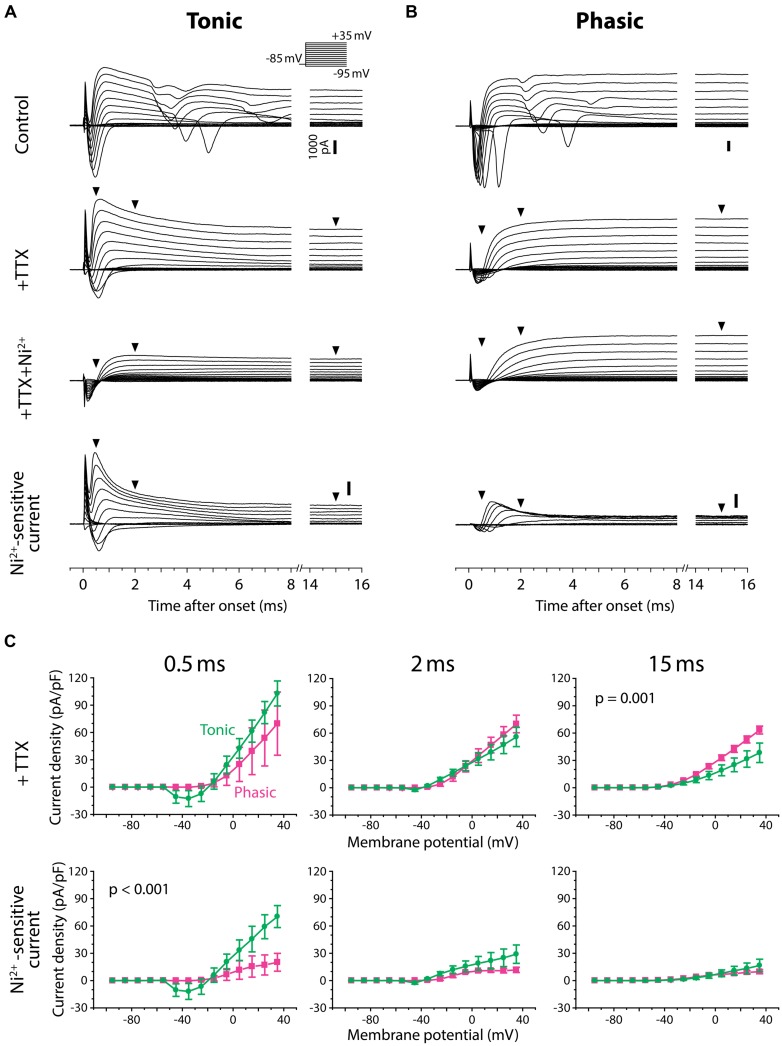FIGURE 7.
Tonic neurons exhibit a larger Ni2+-sensitive outward current than phasic neurons. (A,B) Voltage-clamp recordings from a tonic neuron (A) and a phasic neuron (B) during voltage steps from a holding potential of –85 mV to test potentials between –95 and +35 mV in 10 mV increments [inset in (A)]. Neurons were tested before (control), after application of tetrodotoxin (+TTX), and after combined application of TTX and Ni2+ (+TTX+Ni2+). +TTX+Ni2+ currents were subtracted from +TTX currents to obtain the Ni2+-sensitive currents (bottom). Both tonic and phasic neurons in the control condition showed multiple spikes of inward current in response to test potentials depolarized above –25 mV. The spikes were abolished by TTX, suggesting sodium spikes resulting from a poor space clamp. Vertical scale bars (1000 pA) shown in control are also applied to +TTX and +TTX+Ni2+ currents from the same cell. Bottom, Ni2+-sensitive currents consisted of a fast inward current and an outward current, suggesting that the former was a voltage-gated Ca2+ (Cav) current and the latter was a Ca2+-activated K+ (KCa) current elicited by the Cav current. Note, in the tonic neuron, that the fast transient outward component observed during +TTX application was largely blocked by Ni2+. Arrowheads indicate where the current amplitude was measured in (C) (0.5, 2, and 15 ms after the onset of voltage steps). (C) Current–voltage relationship of +TTX current (top) and Ni2+-sensitive current (bottom) at the times indicated. Current density (current amplitude divided by resting membrane capacitance) obtained from three tonic (green circle) and three phasic (magenta square) neurons was plotted against test potential. To remove capacitive currents due to incomplete capacitance and series resistance compensation, we considered current responses between –95 and –75 mV as passive, and used these to generate a linear estimate of the passive current response at each test potential, which we subtracted from the raw data before averaging (see Materials and Methods for details). p value indicates a significant interaction effect (p < 0.05) between voltage and firing pattern (evaluated by two-way repeated measures ANOVA). A fast-decaying outward Ni2+-sensitive current (at 0.5 ms) was larger in tonic neurons than phasic neurons particularly at test potentials depolarized to –5 mV. Note that the putative transient Cav current was observed at potentials as low as –45 mV (at 0.5 ms), which is below the spike threshold voltage measured in current-clamp (Figure 4). Also note that amplitude of the Ni2+-sensitive steady-state outward current (at 15 ms) was not significantly different between tonic and phasic neurons, but this late component in the +TTX current was larger in phasic neurons than tonic neurons.

